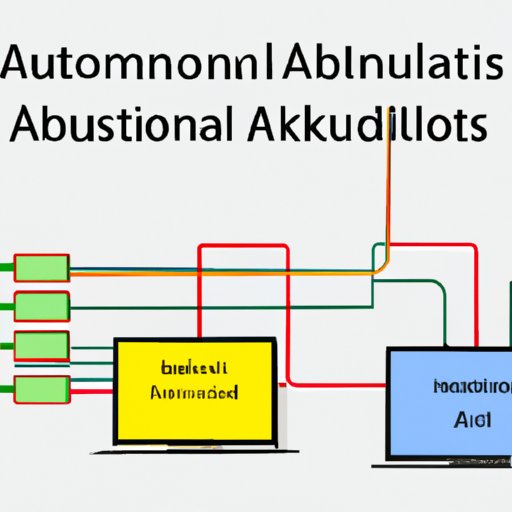
Introduction to Automated Systems: An Overview
Automated systems are computerized processes that can operate without direct human assistance. They have become increasingly popular in recent years due to their potential to improve efficiency and reduce costs. In this article, we will explore the definition, types, benefits, challenges and applications of automated systems, as well as future trends such as artificial intelligence (AI), machine learning and the Internet of Things (IoT).
Definition of Automated Systems
According to a study by the University of Minnesota, “automated systems are defined as physical or virtual systems that use computers, sensors, actuators and other components to perform tasks with little or no human intervention.” Automated systems have been used in various industries for decades, but they are becoming more widespread due to advances in technology such as AI and machine learning.
Examples of Automated Systems
Some examples of automated systems include self-driving cars, robotic process automation (RPA) for businesses, smart homes with voice-activated assistants, and automated factory assembly lines. Automated systems are being used in almost every industry, from healthcare and transportation to manufacturing and retail.
Types of Automated Systems
Automated systems can be broadly divided into three categories: industrial automation, home automation, and business automation.
Industrial Automation
Industrial automation is the use of computers and robots to control machines and processes in factories and other industrial settings. This type of automation has enabled manufacturers to reduce labor costs, increase production speed and accuracy, and improve safety. Industrial automation is used in a wide range of industries, including automotive, aerospace, and consumer products.
Home Automation
Home automation is the use of technology to automate household tasks, such as turning on lights, controlling thermostats, and monitoring security systems. Smart home devices, such as voice-activated assistants, are becoming increasingly popular, allowing users to control their home environment with just a few simple commands.
Business Automation
Business automation is the use of technology to streamline and simplify business processes, such as customer service, accounting, and marketing. Business automation tools, such as robotic process automation (RPA) and artificial intelligence (AI), can help companies reduce costs and improve efficiency.
The Benefits of Automating Systems
Automated systems offer numerous benefits, such as increased efficiency, cost savings, and improved quality and accuracy. According to a study by the University of California, Davis, “the use of automated systems can result in significant cost savings by reducing labor costs, increasing productivity, and improving accuracy.”
Increased Efficiency
Automating systems can significantly improve efficiency by eliminating manual processes, reducing errors, and automating tedious tasks. Automated systems can also help companies save time by streamlining processes and making it easier to collect data and make decisions.
Cost Savings
Automating systems can also help businesses reduce costs by eliminating the need for manual labor, reducing energy consumption, and improving operational efficiency. Automated systems can also help businesses save money by reducing waste and increasing operational efficiency.
Improved Quality and Accuracy
Automated systems can also help improve the quality and accuracy of products and services by reducing errors and eliminating manual processes. Automated systems can also help businesses reduce costs by improving efficiency and reducing waste.
Challenges of Automating Systems
Despite the numerous benefits of automated systems, there are some challenges associated with them. Some of the most common challenges include initial costs, complexity, and security and data integrity.
Initial Costs
One of the main challenges of automating systems is the high initial cost. Automation requires the purchase of specialized hardware and software, which can be expensive. Additionally, companies may need to hire additional personnel to manage and maintain the automated systems.
Complexity
Another challenge of automating systems is the complexity of the technology. Automation requires expertise in programming, networking, and other technical skills, which can be difficult to find. Additionally, managing and maintaining automated systems can be complex and time-consuming.
Security and Data Integrity
Finally, automated systems can pose a security risk if not properly managed. Automated systems store large amounts of sensitive data, which can be vulnerable to hackers if not properly protected. Additionally, automated systems can be susceptible to errors and malfunctions, which can lead to data loss or corruption.
Applications of Automated Systems
Automated systems are being used in a wide range of industries, from manufacturing and transportation to healthcare and retail. Automated systems can be used to automate tedious tasks, such as data entry and customer service, and to improve operational efficiency and accuracy.
Manufacturing
Automated systems are widely used in the manufacturing industry to reduce labor costs, improve production speed and accuracy, and increase safety. Automated systems can be used to control machinery, monitor processes, and optimize production.
Transportation
Automated systems are also being used in the transportation industry to improve safety, reduce congestion, and improve efficiency. Automated vehicles, such as self-driving cars and drones, are becoming increasingly popular, and automated logistics systems are being used to optimize delivery routes.
Healthcare
Automated systems are also being used in the healthcare industry to improve patient care and reduce costs. Automated systems can be used to monitor vital signs, diagnose diseases, and provide personalized treatments.

Future Trends in Automated Systems
As technology continues to advance, automated systems will become even more widespread. Some of the most promising trends in automated systems include artificial intelligence (AI), machine learning, and the Internet of Things (IoT).
Artificial Intelligence
AI is a branch of computer science that focuses on creating intelligent machines that can think and act like humans. AI has the potential to revolutionize automated systems by enabling them to learn from their environment and make decisions on their own.
Machine Learning
Machine learning is a subset of AI that enables machines to learn from data and make predictions. Machine learning can be used to automate processes, such as predicting customer behavior or optimizing supply chains.
Internet of Things
The Internet of Things (IoT) is a network of connected devices that can communicate with each other. IoT has the potential to revolutionize automated systems by enabling them to interact with the physical world, such as controlling machinery or monitoring processes.
Conclusion
Automated systems are computerized processes that can operate without direct human assistance. They offer numerous benefits, such as increased efficiency, cost savings, and improved quality and accuracy. However, there are some challenges associated with automated systems, such as initial costs, complexity, and security and data integrity. Automated systems are being used in a wide range of industries, from manufacturing and transportation to healthcare and retail. As technology continues to advance, automated systems will become even more widespread, with trends such as AI, machine learning, and the Internet of Things leading the way.
(Note: Is this article not meeting your expectations? Do you have knowledge or insights to share? Unlock new opportunities and expand your reach by joining our authors team. Click Registration to join us and share your expertise with our readers.)
